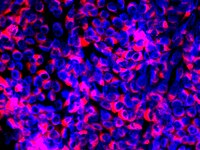
Photo from wikipedia
Endemic Q fever in small ruminants remains an ongoing challenge for veterinary and human public health agencies. Though surveillance programs are implemented in Belgium, infection patterns and vaccination profiles, driving… Click to show full abstract
Endemic Q fever in small ruminants remains an ongoing challenge for veterinary and human public health agencies. Though surveillance programs are implemented in Belgium, infection patterns and vaccination profiles, driving variables, as well as geographical clustering were not presented until now. Based on data from a decade of bulk tank milk analysis between 2009 and 2019, shedding in dairy goat herds declined from 16% (8/50) to 6% (10/162), whereas seroprevalence remained between 32% and 40%. Merely up to two shedding dairy sheep flocks were detected until 2019; seroprevalence peaked in 2017 (43%, 12/28) and declined thereafter. The number of animals in the holding influenced significantly (p = 0.048) the likelihood of shedding, whereas other established risk factors such as uncovered manure, high abortion rates and diversified farm structure could not be confirmed to significantly affect infection on Belgian herd level. Intermittent, incomplete and unsynchronized vaccinated herds shed Coxiella burnetii significantly more often and longer (p<0.001) than continuously, complete and synchronized vaccinated herds. Spatial analyses revealed restricted but matching, homogenous clusters with ≤35km diameter, concentrated in the coastal region close to the border to the Netherlands from 2009-2012, and broadened, heterogeneous clusters with ≥45km diameter between 2014 and 2016 spreading south-west. Though the majority of human cases was notified in this region, the animal clusters could not be allied with Q fever cases. The impact of environmental factors as well as the role of wildlife, rodents and ticks on the transmission between flocks and to humans remains to be elucidated to harness additional epidemiological drivers of Q fever in Belgium. In conclusion, attempts to reduce the burden of Q fever in Belgium should particularly focus on the timely, complete and synchronized vaccination of flocks, including the breeding sire, and particularity in high risk areas. This article is protected by copyright. All rights reserved.
Journal Title: Transboundary and emerging diseases
Year Published: 2021
Link to full text (if available)
Share on Social Media: Sign Up to like & get
recommendations!